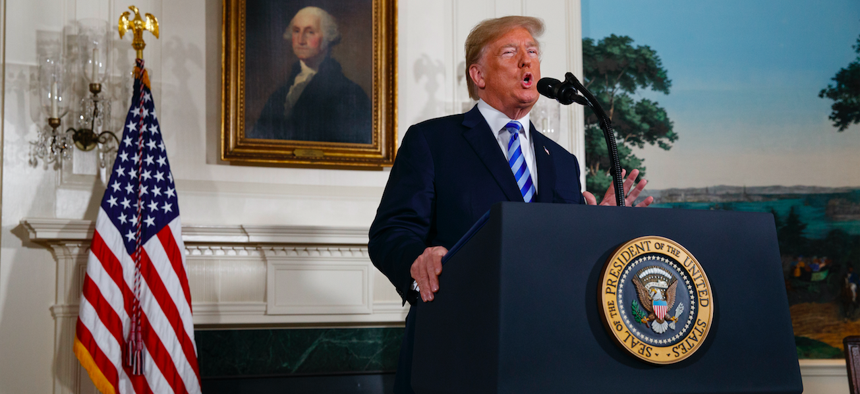
President Donald Trump delivers a statement on the Iran nuclear deal from the Diplomatic Reception Room of the White House, Tuesday, May 8, 2018, in Washington. AP Photo/Evan Vucci
Risks Rise As US Reimposes Sanctions on Iran
Several undesirable consequences are becoming more likely.
This week, a set of Iran sanctions previously lifted under the Iran nuclear deal will snap back into effect as part of President Trump’s complete violation of the accord. Thus far, Iran has avoided rash action, instead seeking to secure concessions from Europe, Russia, and China that could reduce the sanctions’ impact. The cautious response may have lulled the Trump administration into thinking its approach is working, but several potential consequences loom on the horizon.
Renewed proliferation: Before the nuclear deal was signed in 2015, Iran’s heavy-water reactor at Arak was close to going online; it could have produced weapons-grade plutonium for several nuclear weapons per year. Moreover, the deeply buried Fordow facility was already being used to enrich uranium. However, under the nuclear accord Iran destroyed the core of the Arak reactor and agreed to redesign it with international partners so that it would not produce significant amounts of weapons-grade plutonium. Similarly, international partners in collaboration with the Atomic Energy Organization of Iran, or AEOI, are working to turn Fordow into a research-and-development facility, ensuring that Iran experiments with zinc or other benign materials instead of uranium at the site.
Unfortunately, by November, when all the nuclear sanctions snap back, AEOI will likely become a “designated entity.” That means any countries or entities working to repurpose Iran’s nuclear infrastructure to eliminate the risk of weaponization will be subject to U.S. sanctions. If the administration continues with its plans to re-sanction AEOI, it may force Iran to scrap its plans for nuclear accommodations at the key facilities, dramatically increasing the risk of Iranian proliferation.
Reformists undermined: The best hope for sustained moderation in Iran is neither the country’s leaders nor outsiders seeking to manipulate events to their own end, but rather the 80 million Iranians with decades of experience in pushing boundaries and forcing political change. However, the Iranian people can’t succeed if their political space is choked off by U.S. sanctions. As Iranian civil society and human rights defenders have long warned, sanctions and the threat of war inhibit prospects for reform by securitizing Iran’s political environment. While the relief of sanctions and reduction of tensions under the nuclear accord could have reversed these constraints, the snapback of sanctions is all but certain to empower hardline forces that have long stood in the way of progress.
Hardliners in Iran do not fear sanctions and a ratcheting up of tensions, which will harm and divide the Iranian people and enable the Islamic Revolutionary Guard Corps to expand its political and economic power. Rather, hardliners fear an Iran connected to the outside world, an empowered middle class and an organized civil society pushing for a government that truly reflects its wishes—all of which are undercut by U.S. sanctions.
Oil disruptions: Trump has been walking a fine line in seeking to take millions of barrels of Iranian oil shipments per day off the market while avoiding a spike in the price of oil that could severely damage the U.S. and global economy. For now, his strategy has hinged on Saudi Arabia and Russia pumping more oil to keep prices from skyrocketing. Yet, this approach contains substantial risks.
For starters, using spare capacity to cover Iran’s lost oil production creates serious vulnerabilities in the event of an emergency. Recent events have highlighted that such an emergency could be difficult to avoid. Saudi Arabia "temporarily halted" oil shipments through the Bab al-Mandeb strait, at the southern end of the Red Sea, after an alleged attack by Iran-supported Houthi rebels in Yemen. Moreover, this past weekend saw IRGC naval forces conducting major exercises in the Persian Gulf, potentially simulating maneuvers to disrupt the flow of oil through the vital Strait of Hormuz if tensions with the U.S. continue to escalate. Even if there is no emergency event that constricts the flow of oil, the risk of such a scenario will impact market psychology—and very likely the price of oil.
Aside from the increasing risk of economic blowback from rising oil prices, begging Saudi Arabia and Russia to make up for lost Iranian oil ultimately makes the U.S. dependent and reduces its leverage to press those key players on other issues, like Yemen or Ukraine.
Helping Putin: In the wake of the Trump-Putin Summit in Helsinki, it is worth considering just how much Trump’s Iran approach accrues to Vladimir Putin’s benefit. Europe has been forced to choose between sustaining a successful nonproliferation agreement endorsed by the UN Security Council that it helped negotiate and suffering economic pain at the whims of an American President who appears to have hated the accord for no reason other than that his predecessor struck it. America, with no real business relationships with Iran after decades of sanctions, may not feel the pain of sanctions – but Europe will. Not only have major European businesses pulled out of the Iranian economy, but Europe will also be forced to reduce its oil purchases from Iran in order to comply with extraterritorial U.S. sanctions.
This is expediting European planning to find work-arounds and reduce their exposure to U.S. sanctions. And who benefits more from strife in the Transatlantic alliance and diminishing American leadership and sanctions power? None other than Vladimir Putin.

